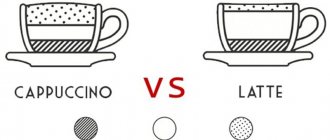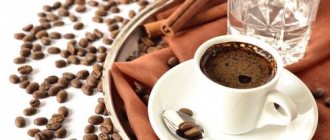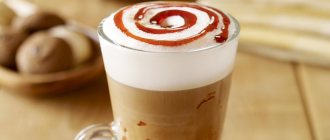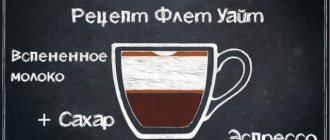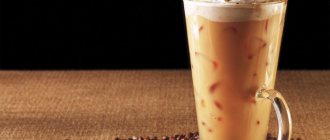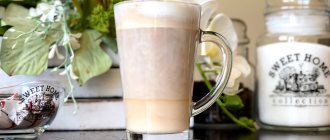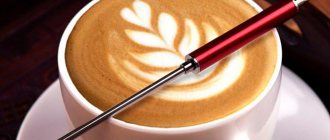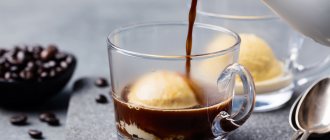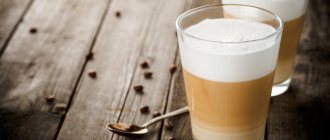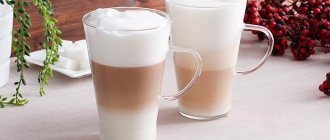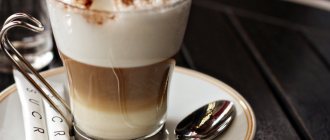Origin of coffee
Both drinks were invented in Italy.
It’s worth starting with the fact that all the similarities of this pair end with their origin and the ingredients from which they are prepared. Both the first and second come from Italy. Latte is a simplified version of coffee latte, which translates from Italian as “coffee with milk.”
The word cappuccino comes from the Capuchin order, which had a red-brown emblem. The drink was very similar in color to the banner, which is how the world-famous name Cappuccino was assigned to it.
Properties, features, differences between latte coffee
Latte macchiato, when properly prepared, is divided into three parts: at the bottom of the container there will be milk, then there will be espresso, and the top will be crowned with thick and persistent foam. These boundaries are easily mixed upon contact.
What seems especially interesting is that the taste of latte macchiato can vary. This is facilitated by the permissible difference in the proportions of a given drink. In each country and even in each coffee shop, these standards vary, and cocktails may differ in taste:
- Austrian baristas offer a delicate Latte Macchiato - 1:1 ratio.
- Europeans serve the same cocktail with proportions of 1:1.5 (espresso, milk).
- Italians like it stronger, based on the proportions - 2:1.
Regardless of the composition, all cafeterias in the world follow the three-layer structure for preparing latte macchiato. This is the difference between a mocha and a latte.
In addition to the combination of proportions, baristas can add variety only to the decoration of the drink - the presentation of the drink to the client.
Difference in Ingredients
The drinks are made from the same ingredients: milk and espresso. It’s just that the proportions of these products are different. Milk in cappuccino is mixed with espresso in a one-to-one ratio. And in Latte - two to one, plus a little foam. Therefore, cappuccino is considered a full-fledged coffee, and latte is considered a delicious coffee drink. But this does not mean that you should write it off, because many visitors to coffee shops and restaurants fell in love with it precisely for its softness and fluffiness of the foam.
Classic latte recipe
To prepare a latte according to the classic recipe, you need to take similar ingredients, but in different proportions. You will need:
- 150 milliliters of milk (fat content 3.2%);
- 50 milliliters of water;
- 2 teaspoons ground coffee beans;
- 2 teaspoons sugar.
Step-by-step instruction:
- Coffee is brewed in the Turk. Sugar is added to the resulting liquid.
- The milk is heated to 65 degrees and divided into 2 parts.
- Beat one milk part with a blender for 2 minutes until a stable foam forms.
- Espresso is poured into a glass with a layer of milk. Afterwards the foam is laid.
Sugar should only be added during the brewing stage of the coffee base. Its amount can be reduced based on your own taste preferences.
Differences in the preparation of drinks
Cappuccino is distinguished by a more densely whipped foam.
If we take the classic method of preparing cappuccino, it is prepared as follows: espresso, usually made on a coffee machine, is poured into a cup. After this, the milk is frothed using steam. If this is not possible, you can shake it in a bottle or shaker.
Then the resulting foam is poured into a cup of espresso in a one-to-one ratio. The foam should be dense. If a handful of sugar is quietly held on the resulting foam, then the cappuccino is prepared perfectly.
The proportion of milk - espresso is increased towards milk
The difference between latte is that it is prepared by mixing the main product with milk in a two to one ratio. The foam in a latte is less thick than in a cappuccino. There is also a latte macchiato. The preparation differs from the first one only in that coffee is added to the finished milk in a ratio of one to two.
Differences by point
Each point in this section will tell you about the differences between latte and cappuccino - natural, healthy and universally loved drinks.
Difference in names
In Italian latte is milk, caffè latte is coffee with milk. In Russian coffee shops they will understand you correctly: if you order a latte, they will prepare you a cocktail of espresso and foamed milk. In Italy, don't count on it: ask for a latte and they'll give you milk. Italians feel the difference between coffee, milk and café au lait. It was the local housewives who were the first to come up with the brilliant caffè latte drink, diluting strong coffee with warm milk to treat their beloved children.
Caffè cappuccino is also of Italian origin. But here we will have to briefly describe the history of its name. Translated from Italian, cappuccio means “hood.” The association with a piece of cassock worn by monks of the Catholic monastic order of the Capuchins gave rise to the name of the drink. After all, the foam cap over a cup of cappuccino resembles the voluminous hood over the head of an Italian church minister. Capuchin – “capuchin” and cappuccino are also consonant words. In addition to linguistic subtleties, it should be noted that in the 16th-17th centuries, ascetic Catholics had little joy and clergy brightened up their meager meals with a tasty and nutritious drink. They adored him!
Interesting: the monks took a lot of risks preparing their own cappuccino. In Italy, coffee was banned in the Middle Ages and considered a diabolical, sinful drink. But the monks, having lightened the dark contents with light milk foam, offered a prayer before the meal, and did not deny themselves the pleasure. Do I think they deserve the gratitude of their descendants?
The robes of the Capuchin monks were brown, or rather terracotta, and the hood was white. This combination of colors also played a role in establishing the name for the cocktail they invented.
External differences
The chance of accurately determining the portion of latte or cappuccino on the table will increase significantly if you pour it into transparent glasses or Irish glasses. A dense, steeply whipped cappuccino foam will occupy a noticeably larger volume in a tall and narrower glass than a glass widened at the top. Latte foam is less durable and lighter, its layer is thinner. Through the glass walls the proportions are clearly visible.
And if instead of a latte they served latte macchiato, then there would be no doubts. The pronounced layering of the macchiato suggests that the drink belongs to the latte family.
Note: the layers in latte macchiato are formed due to the difference in the density of its constituent products and the high temperature of the coffee and frothed milk combined. The thick milk remains at the bottom of the glass, followed by a layer of espresso, with milk foam rising above it.
Different proportions of ingredients
In a latte, a larger amount of milk is added than in a cappuccino, but the process is not focused on achieving a dense foam. You can froth milk for it in a French press, even in an ordinary jar with a lid, and for cappuccino, the cap is carefully formed by whipping the milk with a blender, mixer or cappuccino maker.
It is no coincidence that cappuccino is positioned as a type of coffee, and latte and latte macchiato are called coffee drinks. They are less strong and are recommended for all ages, including children and the elderly.
Personal opinion: I would apply this definition only to latte, because latte macchiato is a stronger version. Double espresso is used for preparation and the layer of coffee remains in a pure form, undiluted with milk. At least until the cocktail cools and the layers are mixed or you break them before drinking. But who dares to ruin the artistic geometry in a glass with a firm hand? And in this case, the amount of caffeine in the macchiato will not change.
Differences in foam structure
Even in such a decorative element as milk foam there are differences. Externally it is white, dense, homogeneous and very appetizing in both drinks. And yet, for latte, a more airy substance is whipped. It looks like a cloud, there are a lot of air bubbles in it, so its lifespan is short - it melts like a cloud.
A different approach to frothing milk for cappuccino. Its foam is no less fluffy, but tighter and denser. This one is more convenient for creating drawings using the latte art technique. For some reason, the design technique was named after latte, but is more often used for cappuccino. But this is not so important, we will not find fault and demand explanations. The main thing is that it is beautiful and festive.
Feed difference
Lattes are usually served in a tall clear glass or Irish glass with a handle. A regular latte can be presented in a large ceramic mug, but hiding the beauty of a macchiato behind opaque walls is unacceptable.
Cappuccino will be served in a large thick-walled cup, the shape of which is widened towards the top. The volumetric space of the upper part conveniently accommodates dense foam, its surface area is larger than in a glass, and for the barista it opens a blank sheet for artistic creativity. Massive walls will not allow cappuccino to cool quickly, so you can enjoy the perfection of taste for a long time.
There should be a spoon for foam near the glass of latte and cappuccino, and a cocktail straw should be placed in the glass with latte macchiato or placed next to the spoon. It will come in handy if you want to taste each layer of the dessert separately, especially if it contains additional layers of bright syrups.
The volume of the dishes must also be correct. Cappuccino is poured into cups with a volume of 150-200 ml, latte into glasses or glasses with a volume of 250-300 ml. It is this size that fully presents the harmony of taste of drinks.
Let's count calories
A 250 ml glass of latte contains 75 kilocalories, a 200 ml cup of cappuccino contains 140 kilocalories. You can find other indicators, the numbers depend:
- on the percentage of fat content of the milk used to prepare the drink;
- the amount of sugar added to coffee;
- on how much and what kind of syrup was added to the latte macchiato;
- how thickly the cap was sprinkled with grated chocolate or nuts.
But there will always be a pattern: the calorie content of cappuccino is higher than that of latte.
How does the feed differ?
Cappuccino is served in a porcelain cup, and latte in a glass glass.
Cappuccino should be served in a porcelain cup with a volume of no more than 150 - 200 ml. The temperature of the milk should be approximately 60 – 70 degrees. You need to pour the milk clockwise, slowly and carefully along the walls of the vessel in which the drink is being prepared.
Latte is served in an Irish glass - a glass glass with a fireproof handle with a volume of 250 to 350 ml, where the temperature of the milk does not exceed 60 - 70 degrees.
Difference with raff coffee
Another type of coffee is raf. It is made from cream, brewed coffee and vanilla sugar. The main difference between raff and the cocktails discussed above is that it is prepared from other ingredients. They also differ in volume. Rough is served in a large cup, like a latte.
Another distinctive feature of raf is the method of preparation. All ingredients are mixed together and only then beaten. In this case, the foam turns out thin, light, and disappears quickly. In other hot cocktails, milk foam is whipped separately until thick, which allows it to be preserved for up to 10-12 minutes.
Which drink tastes stronger?
There is less milk in cappuccino, which is considered a stronger drink
. Cappuccino is considered stronger because it contains less milk, while latte is a softer and more delicate drink. It all depends on the preferences of each person: some like it softer, some like it stronger. Everything is learned by comparison and many people do not immediately notice which of these two types is more delicious.
Ingredients for latte macchiato
The main difference between a latte and a latte macchiato is in the taste. In the first option, the taste of coffee is more pronounced. Therefore, it is not advisable to use mixtures containing robusta to prepare Latte Macchiato.
100% Arabica is ideal. But at the same time, you can do without expensive single varieties. After all, the milky taste predominates in the finished drink. Experts say that latte macchiato, brewed from a mixture of Arabica + Excelsa, has an interesting fruity flavor.
Roasting of beans is possible according to taste, but not darker than Vienna. You can use any grind. This aspect depends on how the coffee base is prepared. The recipe calls for espresso. But you can get by with strong coffee brewed at home in a Turkish coffee pot or a household coffee machine or French press.
Where is the price higher?
The cost of a latte is more expensive than a cappuccino.
Although the ingredients from which the two types of coffee are made are similar, their proportions are different. Therefore, lattes tend to be more expensive than cappuccinos because they require more milk.
Although sometimes in fast food establishments there is similarity in the price of this product. This is due to the fact that the same glass volume is used for latte and cappuccino, for example, 0.3 liters. or 0.5 l. But this approach is not considered correct, since to achieve the ideal taste of coffee, a certain volume is required: latte - 250-350 ml, cappuccino - 150-200 ml.
How to make latte with syrup at home
You will need:
- 50 ml espresso
- 150 ml milk
- 50 ml of your favorite syrup
- Toppings - optional: marshmallows, chocolate chips, coconut flakes, confectionery sprinkles, etc.
Preparation:
- Brewing espresso
- While whisking the milk, add a small portion of the syrup.
- Pour the rest of the syrup into the glass - it is important that it is cool
- Pour warm whipped milk on top
- Carefully add hot espresso
- Lay out a cap of milk foam
This is a simple but versatile recipe for making a delicious coffee and milk drink. Based on it, you can get a new latte every time, adding different and different syrups. Or you can combine several syrups in one drink.
How not to confuse latte and cappuccino
Lattes are made in beautiful layers that can be seen through the glass.
Unfortunately, in some establishments lattes and cappuccinos are made incorrectly. This can be easily noticed. If the buyer knows how these two types of coffee are prepared, then he can easily determine whether they are prepared correctly.
A latte macchiato should consist of clearly visible layers: milk, espresso and foam. This will be clearly visible through the glass beaker. A cappuccino consists of darker espresso and crema. Latte consists of light espresso and foam. The foam should be light and thin: even a handful of sugar should sink in it.
It is better not to use sugar so as not to clog the taste of the drink.
If the serving size is smaller or larger than the norm, then the ideal classic taste is unlikely to be achieved. Cafes usually offer standard, medium and large drinks. It is best to buy the standard one, as it is basically equal to the classic volume.
It’s better not to rush to add sugar to your coffee; it can overpower the taste of real coffee prepared using the original technique. It would be much more correct to buy something sweet to go with your drink. It could be a chocolate croissant or a small cheesecake.
The main thing is to drink coffee slowly, enjoying its taste gradually, and this coffee can be either a latte or a cappuccino.
Let's diversify the taste of your favorite drink
In addition to the classic latte, a latte “with a twist” has a right to exist. Every home cooking lover has their own. Creative personalities with inspiration draw signature designs with chocolate chips on the foam cap; gourmets prefer to invent combinations of taste sensations.
Syrups and spices are added to coffee. The most popular additives are: cinnamon, ground ginger or cloves, ground black pepper, cocoa, vanilla. The field for experimentation is large, but it is better to observe moderation. If you want to personalize your latte, start with tiny doses of the additive, it should only highlight the taste of the natural products.
Remember: the emphasis in the word latte is on the first syllable! This word is Italian, although we often pronounce it in the French manner with the emphasis on the last syllable. No more mistakes! Latte!
I am sure that many of our readers have already mastered the secrets of making a divine latte. I suggest not keeping them in your kitchen and sharing them with us in the comments. Sharing experiences among like-minded people is useful!
